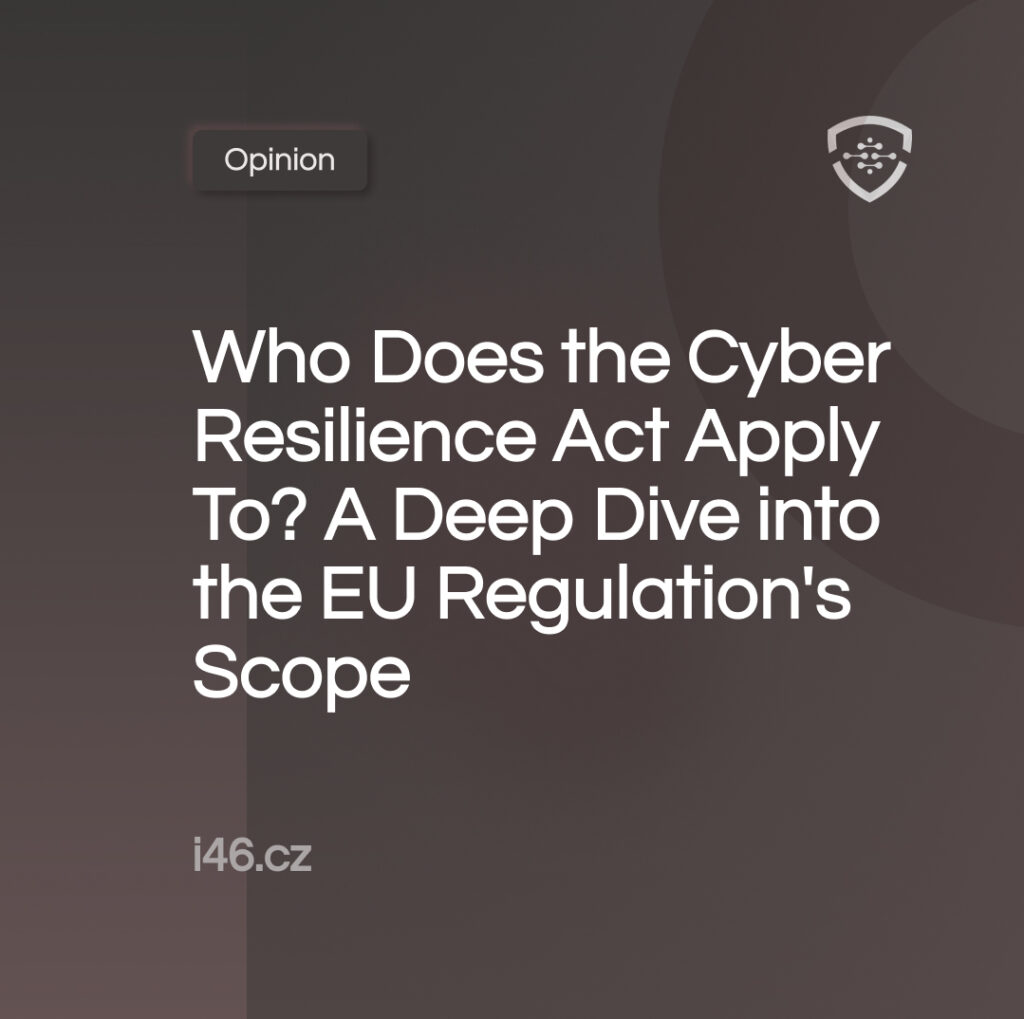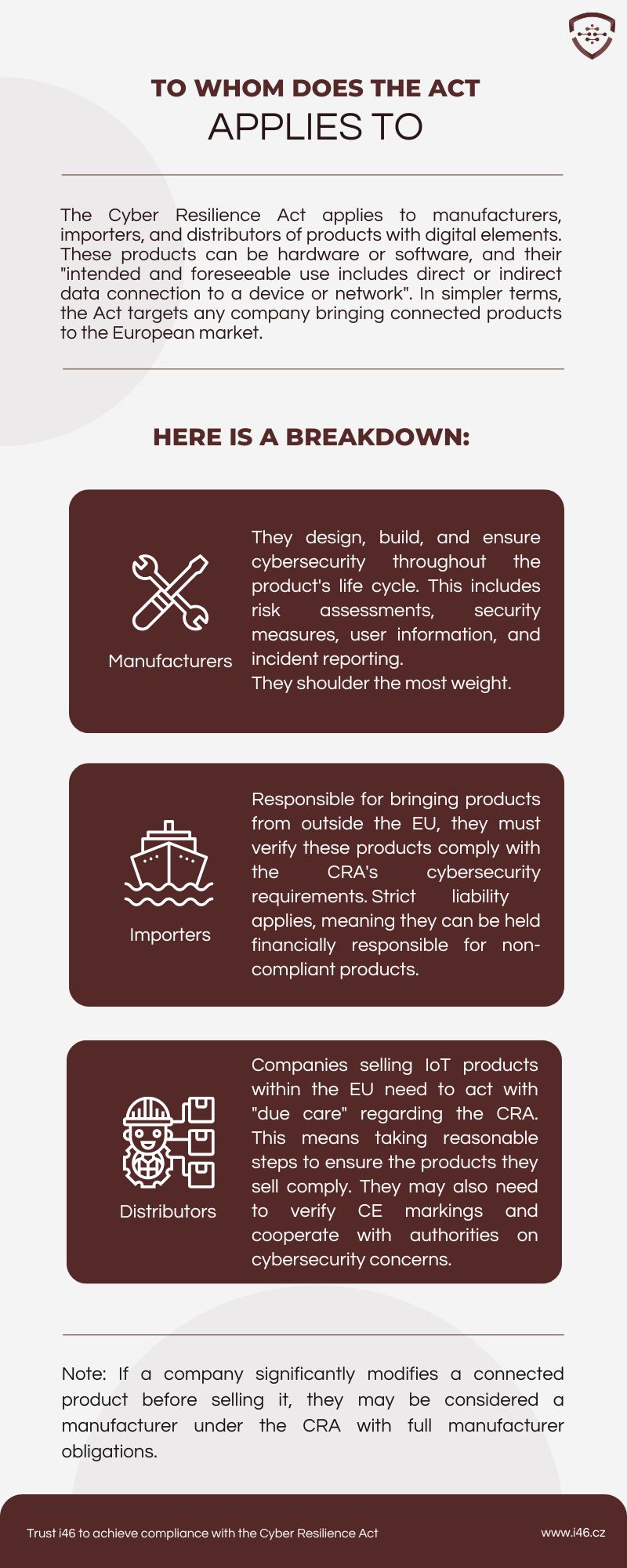Who Does the Cyber Resilience Act Apply To? A Deep Dive into the EU Regulation's Scope (with infographic!)

The Cyber Resilience Act focuses on products with digital elements (PDEs), encompassing a wide range of hardware and software with internet connectivity. But who exactly does the CRA target? Let’s delve deeper into the breakdown of the Act’s reach, exploring the various actors involved and the types of products covered.
The Manufacturers: Bearing the Weight of Responsibility
The primary responsibility under the CRA falls squarely on the shoulders of manufacturers. This includes companies that design, develop, or produce PDEs intended for the EU market, regardless of their location. Whether it’s a European tech giant or a foreign manufacturer, the onus lies on them to ensure their products comply with the Act’s cybersecurity requirements.
The scope of “manufacturers” extends beyond traditional hardware producers. It encompasses:
- Software developers: This includes companies creating applications, operating systems, and firmware with internet connectivity.
- Hardware integrators: This covers companies that combine various hardware components with software to create a final product with digital elements.
- Manufacturers of connected devices: This includes companies producing smart home devices, wearables, connected toys, and any other hardware with internet connectivity.
- Suppliers of spare parts with digital elements: If a spare part for a PDE has digital functionalities, the manufacturer of that spare part also falls under the CRA’s purview.
Here’s a crucial point: the CRA applies throughout the entire supply chain. This means that even if a company outsources some aspects of production or development, the ultimate responsibility for compliance still rests with the manufacturer placing the product on the EU market. They are obligated to ensure that their suppliers and contractors adhere to the Act’s requirements as well.
Beyond Hardware: Understanding “Products with Digital Elements” (PDEs)
The CRA doesn’t target all products. Its focus is on PDEs, which are defined as “hardware or software, or a combination of both, where the intended and foreseeable use of the product includes a direct or indirect data connection with a device or network.” This broad definition encompasses a vast array of products, including some that might not traditionally be considered high-risk from a cybersecurity perspective. Here are some examples:
- Personal computing devices: Laptops, desktops, tablets, and smartphones all fall under this category. The ubiquity of these devices highlights the ever-expanding scope of the CRA.
- Smart home devices: Thermostats, lighting systems, security cameras, and any other device designed for home automation with internet connectivity are subject to the Act. As smart homes become increasingly prevalent, ensuring their security becomes paramount.
- Wearables: Fitness trackers, smartwatches, and other wearable devices that collect and transmit data online are covered under the CRA. With the rise of wearable technology, the need for robust security measures is critical.
- Industrial control systems (ICS): These are specialized systems used to control and monitor physical processes in various industries, and many are increasingly connected to networks. The potential consequences of a cyberattack on ICS can be severe, making the CRA’s focus on their security crucial.
- Medical devices: With the rise of telehealth and connected medical equipment, many fall under the CRA’s umbrella. Protecting patient data and ensuring the functionality of these devices necessitates robust cybersecurity protocols.
- Connected toys: Toys with internet connectivity features, particularly those collecting user data, are subject to the Act. As children interact more with digital elements, ensuring the security of these toys becomes increasingly important.
Essentially, any product that combines hardware and software functionalities and has some level of internet connection is likely considered a PDE under the CRA. This broad definition reflects the Commission’s intent to create a comprehensive framework that addresses the evolving cybersecurity landscape.
Exceptions and Exemptions: Understanding What’s Not Included
While the CRA casts a wide net, some exceptions and exemptions exist, providing clarity for manufacturers operating in specific domains:
- Products not intended for the market: Products solely for internal use within a company or organization are exempt. This ensures the Act doesn’t create unnecessary burdens for internal operations.
- Medical devices with a CE marking already undergoing specific EU medical device regulations: These devices are subject to a different regulatory framework with established cybersecurity protocols.
- Products specifically designed for the armed forces or law enforcement: National security considerations often necessitate specialized equipment that might not always adhere to commercial cybersecurity standards.
- Passive components: Simple hardware components without processing or data transmission capabilities, such as cables or connectors, are generally excluded. The focus is on products with a more active role in the digital ecosystem.
It’s important to note that these exceptions are specific, and manufacturers should carefully assess if their products fall under them.
Ambiguity and Nuance: Navigating the Gray Areas
The vast scope of the CRA, while commendable in its comprehensiveness, can lead to some ambiguity. Certain categories of products might occupy a gray area, requiring manufacturers to carefully evaluate their applicability under the Act. Here are some key examples:
- Open-source software: The CRA exempts non-commercial open-source software from its core requirements. However, complexities arise when open-source software is incorporated into commercial products or offered as a service. Manufacturers utilizing open-source components need to understand their legal obligations in such scenarios.
- Software as a service (SaaS): Cloud-based software solutions often fall under the definition of PDEs. The CRA applies to SaaS providers if their offering qualifies as a remote data processing solution. Understanding the specific terms of service and data storage practices is crucial for determining compliance.
- Products with limited internet connectivity: The definition of “direct or indirect data connection” might be open to interpretation. Products with Bluetooth connectivity or those requiring occasional internet updates could raise questions about their applicability under the CRA.
To address these ambiguities, manufacturers are encouraged to consult with legal counsel specializing in EU regulations and cybersecurity. Additionally, the European Commission is expected to provide further guidance documents and clarifications to help navigate these gray areas.
Beyond Manufacturers: The Ripple Effect of the CRA
The impact of the CRA extends beyond just manufacturers. Here’s a look at how other actors in the digital ecosystem will be affected:
- Distributors and Importers: Businesses bringing PDEs from outside the EU into the market will assume some responsibility for ensuring these products comply with the CRA. They might need to work with manufacturers to obtain necessary documentation and conduct basic checks to mitigate potential risks.
- Consumers: The CRA ultimately aims to empower consumers by ensuring they purchase secure products. Increased transparency from manufacturers regarding a product’s cybersecurity posture will allow consumers to make informed choices.
- Standardization Bodies: The CRA leverages existing and future harmonized standards for cybersecurity. Standardization bodies will play a crucial role in developing and maintaining these standards to provide a clear roadmap for compliance.
- Regulatory Bodies: National enforcement authorities within the EU will be responsible for overseeing the implementation and enforcement of the CRA. They will conduct checks on products, investigate potential non-compliance cases, and impose penalties where necessary.
The CRA establishes a shared responsibility model, where each stakeholder in the product lifecycle plays a role in ensuring the cyber resilience of PDEs.
Conclusion: A More Secure Digital Future for the EU
The Cyber Resilience Act marks a significant step forward for the EU in fortifying its digital landscape. By establishing clear cybersecurity requirements for a broad range of products, the CRA aims to create a more secure and trustworthy environment for both businesses and consumers. Understanding who the Act applies to – manufacturers, the types of products covered, and the broader ecosystem implications – is crucial for navigating its implementation. As the regulatory framework evolves and further clarifications emerge, the CRA has the potential to pave the way for a more secure digital future within the European Union.




